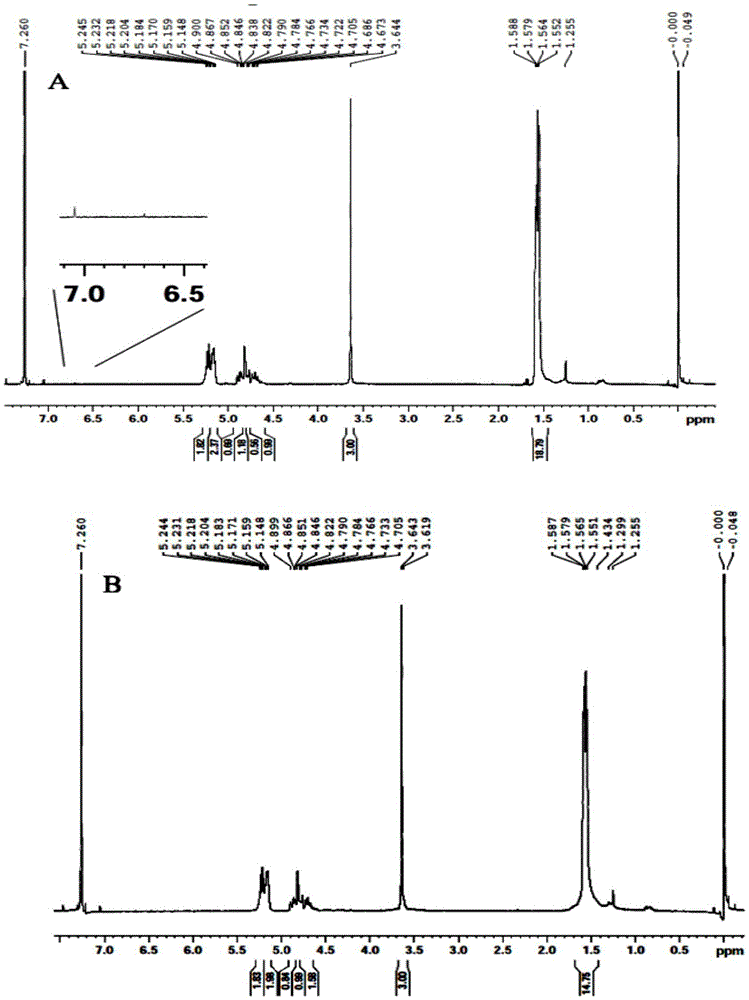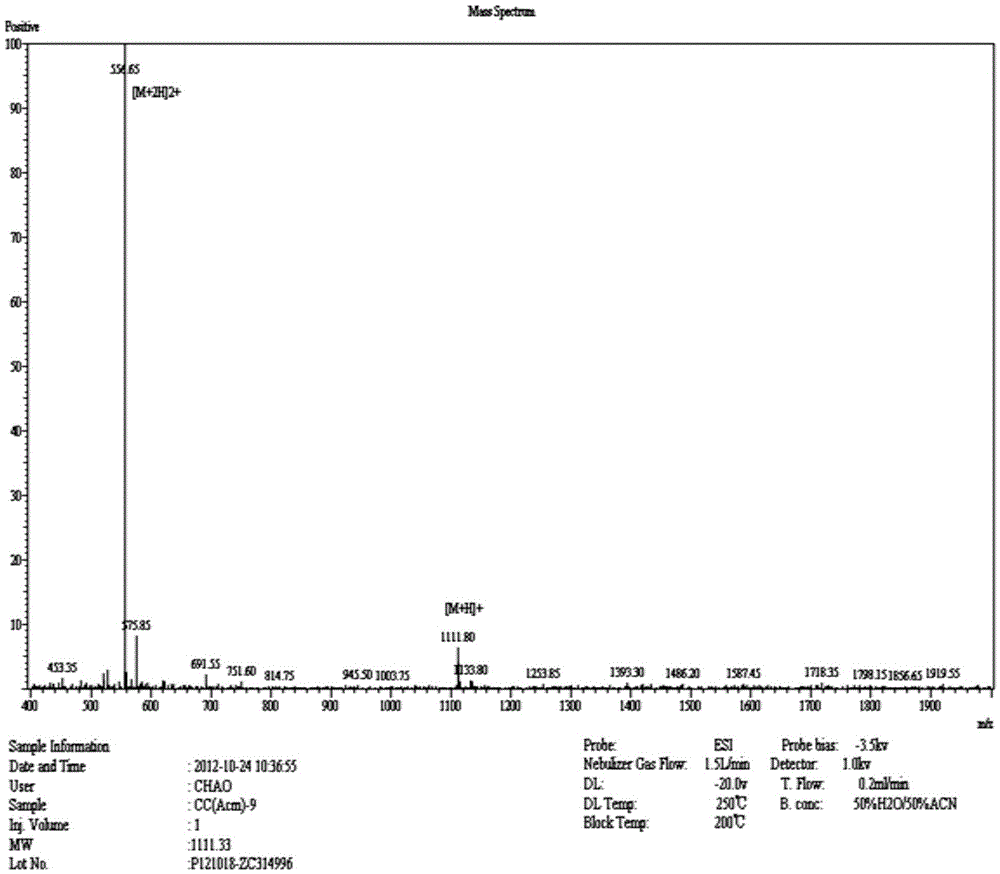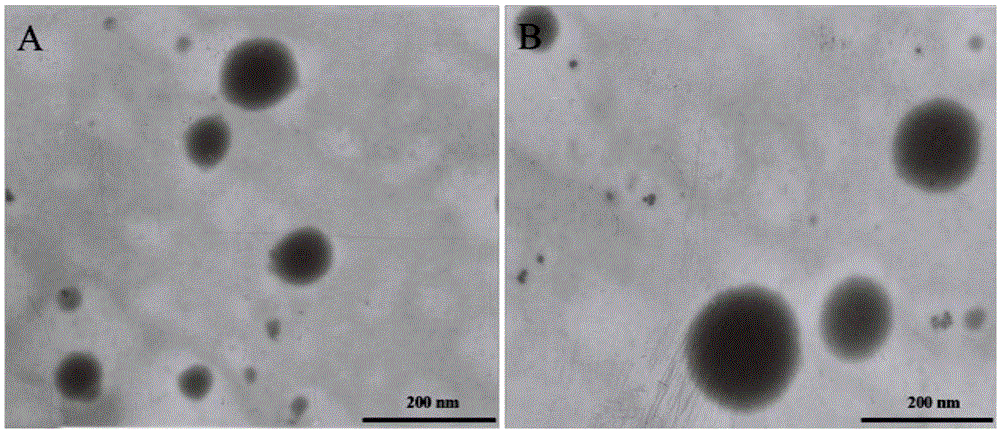A targeted nano drug delivery system mediated by glioma homing peptide and its preparation method
A nano-drug delivery system and glioma technology, which is applied in anti-tumor drugs, pharmaceutical formulations, medical preparations with inactive ingredients, etc., can solve problems such as single function, achieve suitable molecular weight, improve therapeutic effect, and carry function strong effect
- Summary
- Abstract
- Description
- Claims
- Application Information
AI Technical Summary
Problems solved by technology
Method used
Image
Examples
Embodiment 1
[0042] Embodiment 1: the synthesis of Pep-PEG-PLGA
[0043] Weigh 20 mg of Mal-PEG(3500)-PLGA(38000), dissolve it in 2 mL of DMF, add dropwise to 8 mL of phosphate buffer (pH: 7.0), and stir to form a nanoparticle solution. Weigh the Pep-1 (Acm) polypeptide, dissolve it in 2 mL of phosphate buffer (pH: 7.0), add the polypeptide solution dropwise to the nanoparticle solution (the molar ratio of Male to Pep-1 (Acm) is 1:3) , nitrogen protection, stirring, and reacting for 12h. The reacted nanoparticle solution is dialyzed to remove unreacted polypeptide. 1 mL of acetic acid was added to the dialyzed nanoparticle solution, and an appropriate amount of iodine in methanol solution was added dropwise, under nitrogen protection, and reacted for 0.5 hours. The reacted nanoparticle solution is dialyzed and freeze-dried to obtain Pep-PEG-PLGA.
Embodiment 2
[0044] Embodiment 2: emulsification / solvent evaporation method
[0045] Add 1 mg of PTX and MePEG(2000)-PLGA(38000):Pep-PEG-PLGA(38000)=9:1 to dissolve in ethyl acetate, add an appropriate amount of 1% poloxamer 188 aqueous solution, intermittently sonicate (200W, 5min ) to form an oil-in-water (O / W) emulsion, disperse into an appropriate amount of 0.5% poloxamer 188 aqueous solution, stir, remove ethyl acetate by rotary evaporation at 40°C, and filter with 0.45 μm and 0.22 μm microporous membranes respectively, namely get nanoparticles.
[0046] The appearance of nanoparticle solution is clear with obvious blue opalescence. Laser particle size analysis showed that the obtained nanoparticles were normally distributed with an effective diameter of 94.25nm and a polydispersity of 0.117. The nanoparticle has a regular spherical appearance, is well dispersed in the solution and has good stability under a scanning electron microscope. The encapsulation efficiency of nanoparticle...
Embodiment 3
[0047] Embodiment 3: solvent diffusion method
[0048] Add 1 mg of PTX and MePEG(2000)-PLGA(38000):Pep-PEG-PLGA(38000)=9:1 to dissolve in acetone, add dropwise to an appropriate amount of 1% poloxamer 188 aqueous solution, stir, and rotate at 50°C Acetone was removed by evaporation, and then filtered through 0.45 μm and 0.22 μm microporous membranes respectively to obtain nanoparticles.
[0049] The appearance of nanoparticles is clear with obvious blue opalescence. Laser particle size analysis showed that the obtained nanoparticles were normally distributed with an effective diameter of 106.45nm and a polydispersity of 0.165. The nanoparticle has a regular spherical appearance, is well dispersed in the solution and has good stability under a scanning electron microscope. The encapsulation efficiency of nanoparticles is 23.4%, and the drug loading is 1.14%.
PUM
 Login to View More
Login to View More Abstract
Description
Claims
Application Information
 Login to View More
Login to View More - R&D
- Intellectual Property
- Life Sciences
- Materials
- Tech Scout
- Unparalleled Data Quality
- Higher Quality Content
- 60% Fewer Hallucinations
Browse by: Latest US Patents, China's latest patents, Technical Efficacy Thesaurus, Application Domain, Technology Topic, Popular Technical Reports.
© 2025 PatSnap. All rights reserved.Legal|Privacy policy|Modern Slavery Act Transparency Statement|Sitemap|About US| Contact US: help@patsnap.com



